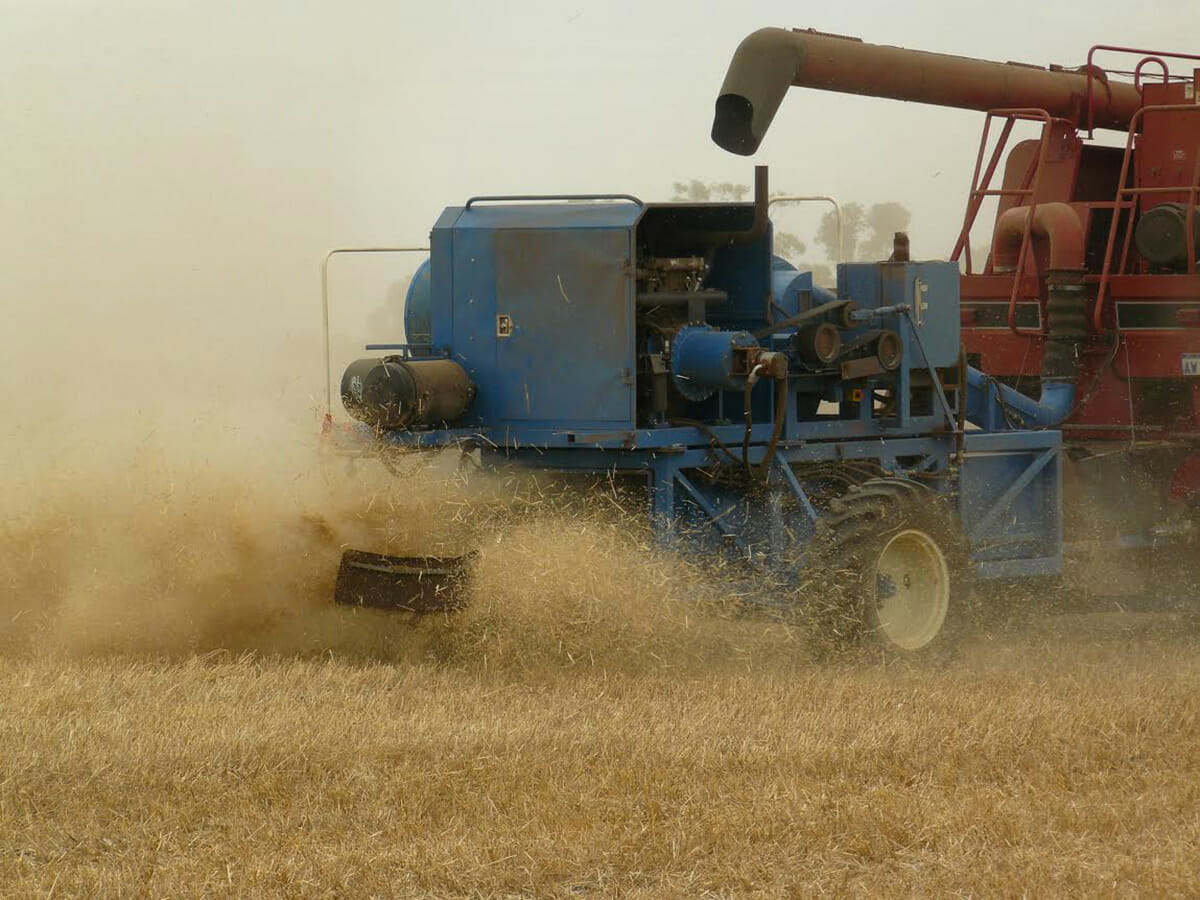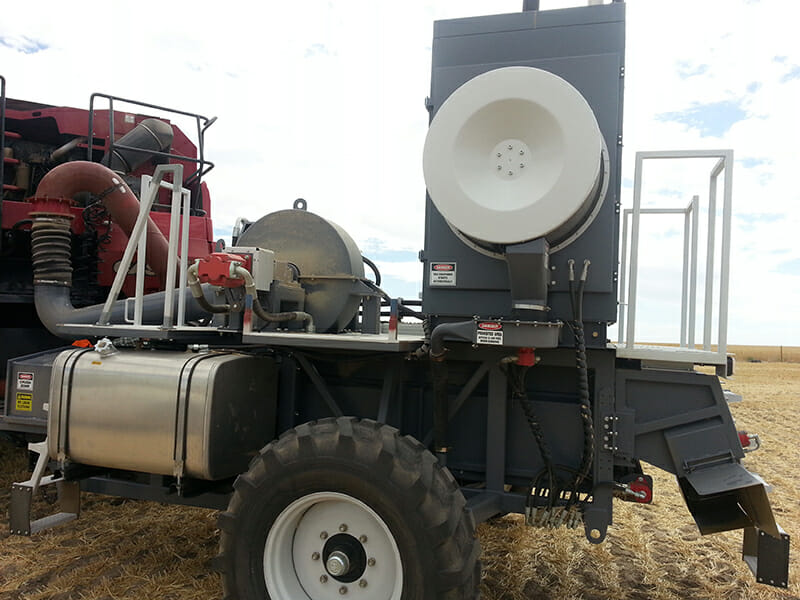Resistant Weeds? Pulverize the Seeds
Hate weeds? Ditch the weed killer and just try crushing the seeds.
Resistant Weeds? Pulverize the Seeds
Hate weeds? Ditch the weed killer and just try crushing the seeds.

Australia’s troubles with resistant weeds — mainly annual ryegrass — started around 1990, says Stephen Powles, a plant scientist at the University of Western Australia who is known by some as the “herbicide resistance guru.” Ryegrass grew resistant to multiple herbicides because its relevant genetic mutations were metabolic. In other words, the plant could flush out herbicides – even compounds it had never before encountered.
The herbicide-guzzling weeds forced Australian farmers and agronomists to get creative. They incorporated traditional techniques such as crop rotation, which promotes soil health and mixes things up so weeds don’t get too comfy, and tilling, which uproots unwanted plants. But around a decade ago a farmer named Raymond Harrington started tinkering with a new approach.
‘Most things happen first in the U.S., and then the technology comes to Australia. This is an example of where it came first to Australia.’
“Most things happen first in the U.S., and then the technology comes to Australia,” says Powles, who started collaborating with Harrington in 2005. “This is an example of where it came first to Australia.”
With the help of a bioengineer, Harrington developed a weed-seed-chomper that attached to the rear of a combine. Typically, combines sort grain from chaff and other unwanted bits of plants, including weed seeds – the latter mixture is spit back on the field. Harrington’s modification directed this mix into a trailer, which had two cage mills spinning in opposite directions to grind the seeds so they couldn’t grow. The Harrington Seed Destructor was born.
The machine was commercialized in 2013, although just a handful have sold in Australia so far — possibly because farmers are holding out for the next generation, which will be incorporated into a combine. If the seed destructor is more widely adopted, it shows promise. Research by Powles, Harrington and Michael Walsh, a weed agronomist at the University of Western Australia, suggests the machine can destroy between 95 and 99 percent of weed seeds, depending on the species and the mill speed.
If more farmers do use the Harrington, it will take awhile to see the results, says Walsh: “The effects are not instantaneous, where you can see a dramatic difference overnight. But we have trial evidence that says you can take populations that are truly out of control at 100 plants per hectare down to less than one plant per hectare over a five-year period.”

In cases of resistant weeds, he adds, the tech will become increasingly important as a tool in what weed control folks call integrated pest management, which uses several approaches together — including herbicides — smartly and judiciously.
Walsh is currently on an eight-stop North American tour through the U.S. and Canada, where he and a team of Australian farmers are running workshops to introduce the technology to new markets.
The seed destructor is making its debut in American agricultural academia, too. Jason Norsworthy, a weed scientist at the University of Arkansas — a state inundated with resistant palmer amaranth – recently purchased one of the machines, which he hopes to have by next growing season. But whether or not the Harrington will work in the US will depend on how well it handles the local seeds.
“No one has evaluated the machine on palmer amaranth,” says Norsworthy. “That’s a very, very small seed, and we’re obviously anxious to see how effective it’s going to be on that.”
Let’s hope it is.
Follow us
This work is licensed under a Creative Commons Attribution-NoDerivatives 4.0 International License.
Want to republish a Modern Farmer story?
We are happy for Modern Farmer stories to be shared, and encourage you to republish our articles for your audience. When doing so, we ask that you follow these guidelines:
Please credit us and our writers
For the author byline, please use “Author Name, Modern Farmer.” At the top of our stories, if on the web, please include this text and link: “This story was originally published by Modern Farmer.”
Please make sure to include a link back to either our home page or the article URL.
At the bottom of the story, please include the following text:
“Modern Farmer is a nonprofit initiative dedicated to raising awareness and catalyzing action at the intersection of food, agriculture, and society. Read more at <link>Modern Farmer</link>.”
Use our widget
We’d like to be able to track our stories, so we ask that if you republish our content, you do so using our widget (located on the left hand side of the article). The HTML code has a built-in tracker that tells us the data and domain where the story was published, as well as view counts.
Check the image requirements
It’s your responsibility to confirm you're licensed to republish images in our articles. Some images, such as those from commercial providers, don't allow their images to be republished without permission or payment. Copyright terms are generally listed in the image caption and attribution. You are welcome to omit our images or substitute with your own. Charts and interactive graphics follow the same rules.
Don’t change too much. Or, ask us first.
Articles must be republished in their entirety. It’s okay to change references to time (“today” to “yesterday”) or location (“Iowa City, IA” to “here”). But please keep everything else the same.
If you feel strongly that a more material edit needs to be made, get in touch with us at [email protected]. We’re happy to discuss it with the original author, but we must have prior approval for changes before publication.
Special cases
Extracts. You may run the first few lines or paragraphs of the article and then say: “Read the full article at Modern Farmer” with a link back to the original article.
Quotes. You may quote authors provided you include a link back to the article URL.
Translations. These require writer approval. To inquire about translation of a Modern Farmer article, contact us at [email protected]
Signed consent / copyright release forms. These are not required, provided you are following these guidelines.
Print. Articles can be republished in print under these same rules, with the exception that you do not need to include the links.
Tag us
When sharing the story on social media, please tag us using the following: - Twitter (@ModFarm) - Facebook (@ModernFarmerMedia) - Instagram (@modfarm)
Use our content respectfully
Modern Farmer is a nonprofit and as such we share our content for free and in good faith in order to reach new audiences. Respectfully,
No selling ads against our stories. It’s okay to put our stories on pages with ads.
Don’t republish our material wholesale, or automatically; you need to select stories to be republished individually.
You have no rights to sell, license, syndicate, or otherwise represent yourself as the authorized owner of our material to any third parties. This means that you cannot actively publish or submit our work for syndication to third party platforms or apps like Apple News or Google News. We understand that publishers cannot fully control when certain third parties automatically summarize or crawl content from publishers’ own sites.
Keep in touch
We want to hear from you if you love Modern Farmer content, have a collaboration idea, or anything else to share. As a nonprofit outlet, we work in service of our community and are always open to comments, feedback, and ideas. Contact us at [email protected].by Brooke Borel, Modern Farmer
August 20, 2014
Modern Farmer Weekly
Solutions Hub
Innovations, ideas and inspiration. Actionable solutions for a resilient food system.
ExploreExplore other topics
Share With Us
We want to hear from Modern Farmer readers who have thoughtful commentary, actionable solutions, or helpful ideas to share.
SubmitNecessary cookies are absolutely essential for the website to function properly. This category only includes cookies that ensures basic functionalities and security features of the website. These cookies do not store any personal information.
Any cookies that may not be particularly necessary for the website to function and are used specifically to collect user personal data via analytics, ads, other embedded contents are termed as non-necessary cookies.